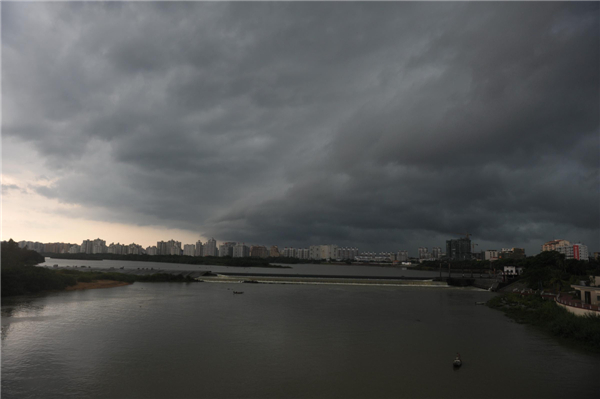

BEIJING - An orange wave warning for Typhoon Utor was raised to red on Tuesday afternoon, according to the National Marine Environmental Forecasting Center.
Utor, the 11th typhoon to hit China this year, is expected to make landfall in South China's Guangdong province between Wednesday evening and early Thursday morning.
 |
|
Menacing clouds gather above the Wanquan River in Qionghai city, South China's Hainan province, on Aug 13. [Photo/Xinhua] |
The State Oceanic Administration issued a first-level emergency response on late Tuesday, urging the administration's South China Sea branch to send working teams to direct disaster prevention efforts.
The administration's National Marine Hazard Mitigation Service was asked to send working teams to carry out a disaster survey in the area.
The administration also asked relevant departments to carry out disaster prevention work in accordance with the first-level emergency response.
The center said waves as high as 11 meters will appear in the northern part of the South China Sea from Tuesday night to Wednesday, adding that waves up to six meters high will appear in coastal areas in Guangdong.
Utor is also expected to whip up sea waves of 3.5 to 4.5 meters on the northeast coast of South China's Hainan province and Guangdong's eastern coastline.
Ships in these areas should take care to avoid the waves and local authorities should take precautionary measures, the center urged.
The center also raised its storm tide warning to orange, as water levels on the coast of Guangdong are expected to increase by 60 to 300 cm from Tuesday afternoon to Wednesday evening.
The center called for authorities to reinforce fishery facilities and inspect sea walls and waterlocks.
China uses a four-tier color-coded weather warning system, with red representing the most severe weather, followed by orange, yellow and blue.
The National Commission for Disaster Reduction also issued an early disaster warning on Tuesday morning, asking local governments to prepare for the arrival of Utor.
The typhoon may also be felt in the Guangxi Zhuang autonomous region and the provinces of Fujian and Yunnan in South China, according to the commission.
Local authorities have been asked to remain on duty around the clock, enhance monitoring, issue early warnings, evacuate residents in threatened areas in a timely way and call fishing boats back to port.